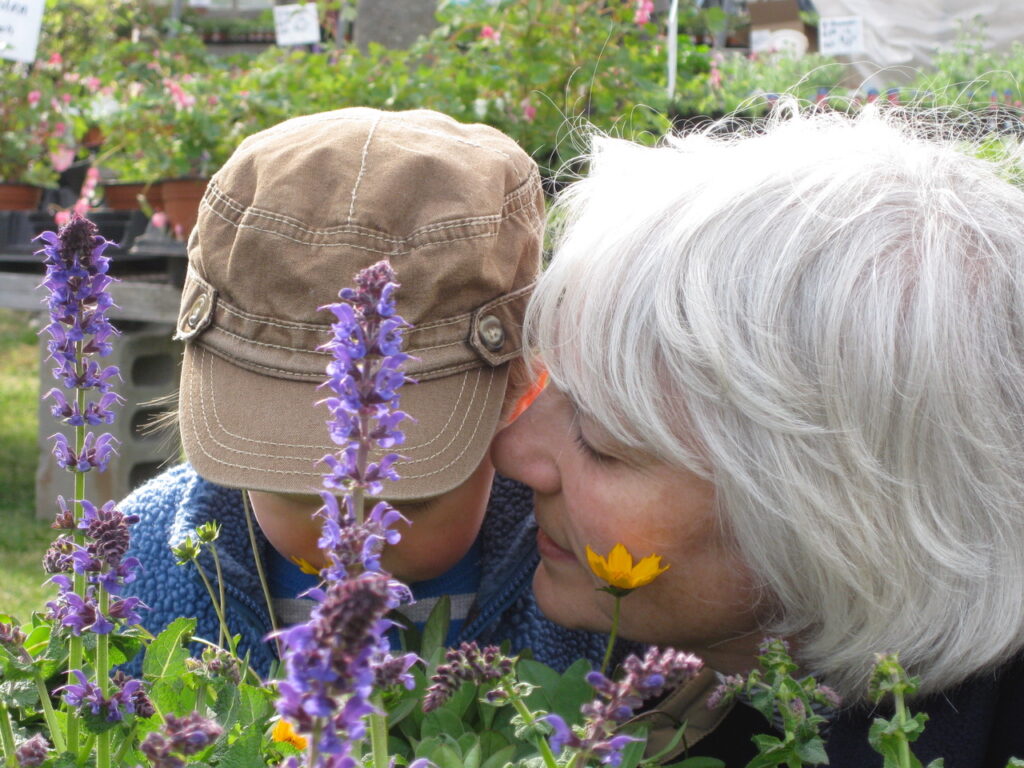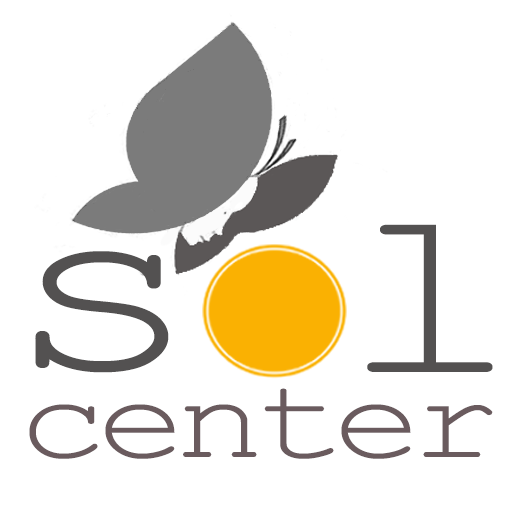Educate the People Who are Interested and That’s Enough
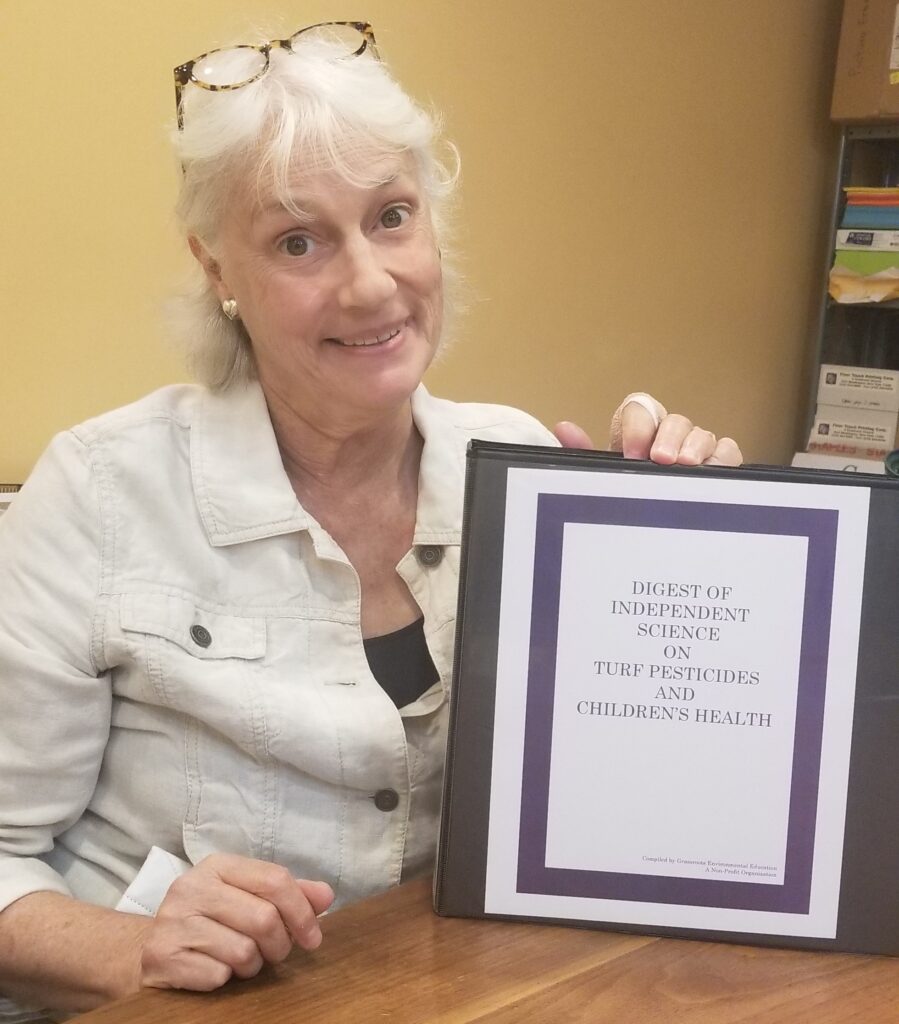
Patti is the executive director of Grassroots Environmental Education www.GrassrootsInfo.org, a science-based environmental health non-profit, seeking to inform the public and decision makers about the health risks of common environmental exposures and to empower individuals and organizations to act as catalysts for change in their own communities. Patti is a Visiting Scholar at Adelphi’s College of Nursing and Public Health and a lecturer at Stony Brook and Hostos. As you will see below, Patti is a force of nature when it comes to environmental health advocacy. She is also a violinist, a teacher and an amazing baker.
I met Patti in the summer of 2018, as we were both standing up against the sacrifice of the most beautiful healthy trees on Main Street, Port Washington NY, in the name of a sidewalk modernization project. To all of us who were there, it was obvious that perfectly healthy trees, protecting our air, giving us shade and offering homes to the wildlife should have been accommodated when the sidewalks were replaced. Although those trees ended up being sacrificed by those in charge with the project, the local tree law has changed as a result of the advocacy of Grassroots and other local environmental organizations.
Adina Dabija: Patti, I am absolutely fascinated by your work. You are an activist and an advocate for clean air, clean water, a safe food supply, and for stricter regulation of radiation and chemical toxins. You also organize, together with Doug, your husband, a 100% organic local farmer’s market, here in Port Washington, New York. Every Saturday there is a long line for your organic blueberry muffins. How did you become an activist?
Patti Wood: That happened when I became a mom. I was 29. When my kids started school, I became a class mother and started a nutrition committee because the school lunches were not very healthy. As part of that effort, I created an organic garden and cafeteria composting project at the Sousa Elementary School in Port Washington.
Adina: Oh, I love it!
Patti: It’s still there, after so many years. Every Friday afternoon I was there weeding and cultivating, waiting for my kids to finish school and come out to the garden. Sometimes, they even helped out before we went home. That was our routine. One day I saw two school employees coming toward the garden with backpack tanks filled with pesticides and sprayer wands in their hands. And I said, “Where are you going?” They told me they were going to spray all the way around the garden’s fence line. I said, “No! we are actually growing vegetables here to eat, and why are you doing this anyway on school property? Why are you spraying poisons where kids play?” Well, it was clear this had to stop.
So I went to the school board and to the superintendent, and I told them we needed a school board policy in Port Washington banning the use of pesticides on school property, period. It took a couple of weeks for the school board to set up a meeting, where I presented my draft policy. This is how I got started. You write the draft policy yourself because you can’t wait for six months for them to come up with it. Not their fault, just administrative delays! They liked the draft, and it came up at the next school board meeting and they passed it… So, we became the first school in New York state to ban pesticides on school grounds!
Adina: Amazing!
Patti: Then I got calls from other parents from other districts, like Manhasset and Locust Valley. They wanted their kids to play on pesticide-free fields too, so I just sent around the policy and eventually over six months, we had 17 school districts in downstate counties that had passed some kind of school board policy banning or limiting pesticides. Going pesticide-free was cost effective and efficacious – which means that it works! Then I went to Albany – I had never been to Albany before – with letters from school districts saying how important it was for us not to put children’s health at risk. And oh, by the way, not to poison our environment or our drinking water either. So we caught the industry completely by surprise. They had no idea this was going on. We made these beautiful folders filled with the independent scientific research on children’s health and pesticide exposure for every single legislator in New York State and they wrote and passed legislation. We had some wonderful legislators who sponsored the bill and put a lot of effort into it. So, New York State has, to this day, the only ban on pesticides at schools in the country. And that law banned pesticides at all schools, kindergarten through 12th grade; public, private, parochial, including daycare centers. The industry was like, whoa, we’re not going to let this happen anywhere else.
That was in 2010. And then just in 2020, 10 years later, we were able to help write legislation for the New York City Council which was passed on Earth Day of 2021. Every single city council member voted to ban the use of chemical pesticides on the grounds in all 3000 plus New York City parks. And that went into effect on November 22nd, 2022. Now, our small coalition of dedicated non-profits called “Eco- Friendly Parks for All” is training NYC Park’s personnel.
Adina: Congratulations! How did you convince the legislators?
Patti: I was very lucky because Doug and I have a weekly radio show in New York City, which is also syndicated across the country, and we got a call from then Eric Adams’ campaign/media person who asked if he could be on our radio show. We were thrilled. So we had a really interesting interview, he eventually won the election, and we had made a good contact in the new mayor’s office. That person was able to facilitate meetings with the Park’s Department that would have been difficult without her help. You know, everyone likes the status quo, and that seems to be particularly true for government agencies. It would not have happened though, without the input of the coalitions, which represented animal rights groups, black and brown communities who are disproportionately exposed and environmental health activists.
Adina: How about the parks here in Port Washington? Are they also pesticide-free?
Patti: Um, well, some of them are parks that are owned and maintained by the villages – like the village of Baxter Estates and Flower Hill. Port Washington North has that park all along Manhasset Bay, and Manorhaven has its own parks. But then the other ones are owned and maintained by the Town of North Hempstead.
Around twenty years ago, the Town’s Ecological Commission, of which I was a member, wrote an OPM policy for town-owned properties. OPM means Organic Pest Management and it only allows for non-toxic solutions to pest problems. It is very different from a more commonly used IPM (Integrated Pest Management) policy, which is an industry supported program. IPM policies promote using the least toxic solution first, but then, if that doesn’t work, you can use anything, even very toxic products. There are just a handful of OPM policies in the country. While I am not sure that the OPM policy survived all these years and administrations, the Town seems to be very careful about using pesticides on parks where children play.
But many of our parks have a local landscaper maintaining them. For instance, years ago in the Landmark Park, they were spraying pesticides like crazy. And I was like, “No, you can’t do this! This is a children’s center. These are the most vulnerable and youngest kids. Their bodies are rapidly developing, and they have typical behaviors that put them at greater risk, like playing on the ground and putting their hands in their mouth.”
Adina: What are some of the effects of pesticides on children?
Patti: Oh, the effects of pesticides on children are many. We have clear evidence that pesticides are linked to certain cancers, neurological problems, endocrine disruption and asthma, among others. We have a whole list of studies on our organization’s website. [https://www.grassrootsinfo.org/pesticide-digest] We’re a science-based organization, so everything is about the science. If we don’t have a robust body of science and an active scientific research community, we don’t touch it.
Adina: And where did you find these organic methods? Are those efficient?
Patti: We use Chip Osborne’s Natural Turf Management. Chip Osborne, who’s from Marblehead, Massachusetts, is the nation’s leading expert in organic turf and we have worked together for decades. We have all these educational materials we made with him that we send out to schools, local governments and the like. He has even converted the National Mall in D.C. to organics!
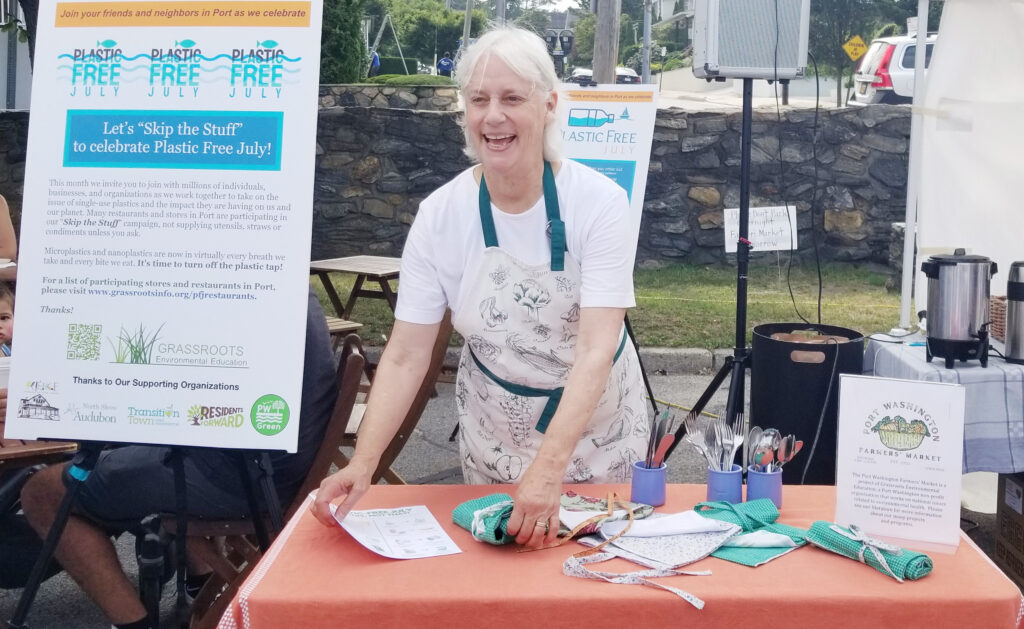
Patti at Port Washington Farmer’s Market, advocating for microplastic/ nano plastic free utensils.
Adina: Patti, what was absolutely fascinating to me from the very beginning when I met you was how you and Doug, your husband, are working together to make this town a better place: you organize the local farmer’s market, create and present environmental education programs in the schools and all the Grassroots campaigns, you even make music together, teach music and support young artists. How did you meet Doug?
Patti : Doug and I were both raised here in Port Washington. Our parents actually built their own houses. I’m not sure that there are any other families here who could say they actually built their own homes with their own hands. We both had very capable fathers, who, by the way, were not builders! So Doug and I spent our early years not really knowing each other very well, but competing in school academically and in music. Music was our first career – before we started our non-profit work. I was a professional flutist, playing solo gigs, recording sessions and playing in chamber groups in New York City. It was just great fun. But it turns out that a professional career in music, especially as a flutist, meant late night rehearsals, traveling and being away in hotel rooms – not something that I wanted. I wanted to be home, baking bread, having a garden, raising my children, teaching piano, flute and Dalcroze Eurythmics and having our own music publishing business, which we did, for many, many years, and still do! Doug is writing music right now as we speak, this afternoon.
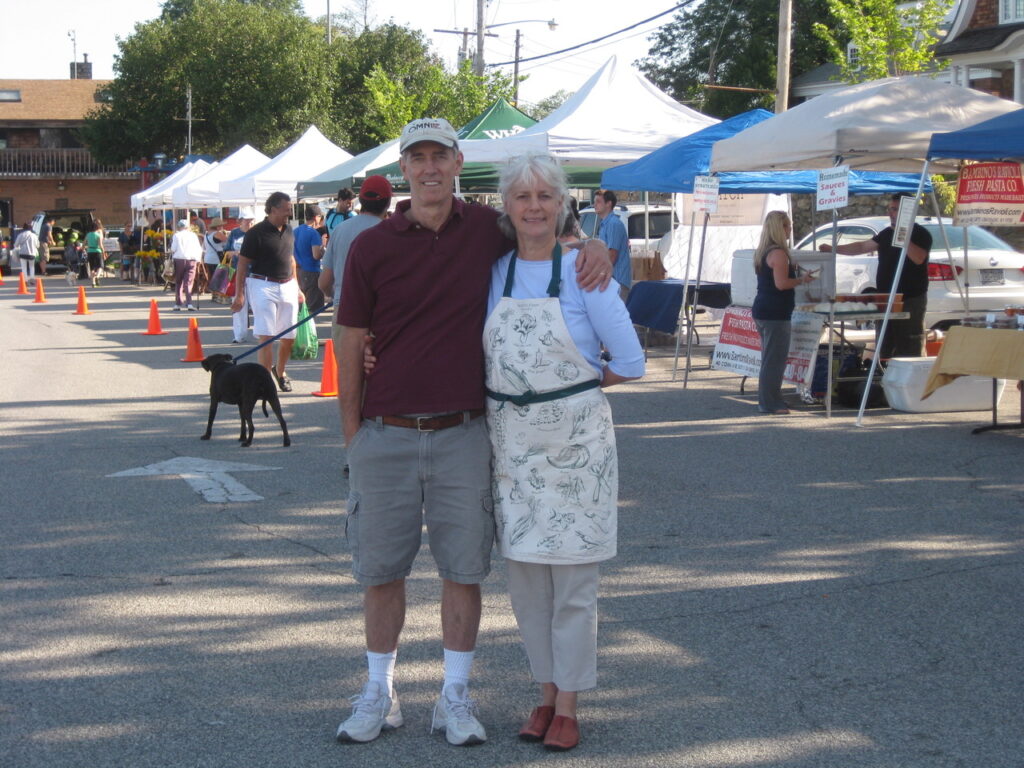
Patti and Doug Wood at the farmer’s market they established in Port Washington
Adina: This is great to hear! Tell me about your career in music.
Patti: I was very fortunate to begin classes in Dalcroze Eurythmics as a very young child and that gave me a wonderful introduction to music. It was the inspiration for my teaching music later on. I played the flute since I was in 4th grade and continued right through college and beyond. I studied with the best of the best teachers. Francis Blaisdell was my most beloved and influential teacher, and I also took master classes with French masters, Jean-Pierre Rampal and Marcel Moyse, who is the God of the flute world. Every flutist in the world knows Marcel Moyse. He was just an amazing, amazing human being, as well as being a treasure of the music world.
I always felt like I had to pass on everything that was given to me, so I couldn’t just take what I learned from these incredible masters and not share it. So I spent a lot of time teaching flute, which was really nice because when I had young children I was home – all my students came to my house. I had opportunities that a lot of people don’t have – to develop my career at home, while raising my children and not having to think about daycare for them. I still teach piano and flute – just because I have to keep my hand in it. I love to start with a child who knows nothing about music and transform them into a real musician with all of the best skills. I always talk about building a musician on cement blocks as opposed to toothpicks. In the schools, they’re building musicians on toothpicks because they’re not really teaching them music fundamentals along with their instrument. So I’ve had many wonderful students over the years, many of whom have gone on to have great careers. And even if their careers are not in music and they ended up as doctors, lawyers, politicians, whatever – they are musicians and they still play. Teaching music was also an opportunity to develop personal relationships with all of these young people and be able to share other things with them, values that I thought were so important, that I thought were missing in their lives. You know, like making things with their hands, art, food, nature, literature.
Adina: What is your teaching style? What is different when teaching at home versus in a formal setup?
Patti: Kids are less inhibited when they are not in school or even in a music studio. Often they’d come to their lesson and tell me about a terrible thing that happened to them in school that day, usually about someone being mean. It’s such a common experience in middle school and even high school. And I was able to kind of walk them through it, you know, and just say, “You know what? The world is not so bad.” This is a really difficult age, where everybody’s trying to put their stake in the ground and say, this is who I am, and I’m cool and you’re not. I tried to tell them that these experiences will have no impact on their life when they graduate from high school and become their own person. So I loved having that opportunity to help shape the lives of young people. I think it’s important to have somebody besides their parents who can show them what’s important in life, because right now most kids have no idea what’s really important.
They’re on electronic devices all day long. It’s so distracting and keeps them from having all those experiences that they need to have to relate to the world around them and build relationships. Living on a screen, on a piece of plastic, they become so passive. It’s just terrible. It’s also really harmful. Not just psychologically harmful, but also harmful to their physical health. We know all about the blue LED lights coming off the screens having an impact on the retina of their eyes, but it’s also having an impact on their body’s ability to produce the hormone melatonin, which is produced by the pineal gland in the brain. The pineal gland produces melatonin when it gets dark at night, but bright screens interfere with this. Because we are living things just like every other living thing on this planet, our bodies are working on a biological circadian rhythm where it’s dark at night and light during the day. Now we’re changing the normal sequence of a 24 hour day and disrupting sleep patterns and creating havoc with hormones. Disrupting hormone activity during puberty can have many harmful consequences.
Adina: Yes! And how about the foods derived from cow’s milk and meat from animals injected with hormones?
Patti: A lot of that is from animals that have been given artificial hormones that stimulate growth. The problem is that small amounts of these hormones and other drugs the animals are given (like antibiotics) wind up in the food we eat. Food contamination issues can be another whole conversation.
Adina: What would you consider your biggest challenge?
Patti: Some of the biggest challenges are that you’re up against huge and powerfully connected industries. It’s a David and Goliath situation. Always. Everything we do is that, you know. We’re the little guys and they’re the big guys and how do you find the holes in their armor, right? You can do it that way little by little, but you have to talk to politicians that are bought by the industry. Right? So if a politician looks like he may be swayed toward doing what we’ve asked him to do (otherwise known as the right thing to do), the industry is right there saying they’d like to make a contribution to their reelection campaign. You know, that kind of thing is so common. So it’s really hard. Or politicians have investments in, say, the telecom industry. The telecom industry is this huge industry with a lot of influence and very deep pockets. So a lot of these politicians not only are taking contributions from the industry that is polluting, but they’re also invested in those industries that are polluting. So how do you get around that?
We get around it by being creative and smarter, and of course, the science drives us to keep going. We have been very lucky that individuals and foundations have reached out to support our work. Having never run a non-profit before Grassroots, it had never occurred to us that fundraising was actually a really important part of it, but we have never hired a development person. We are doing just fine with a small dedicated paid staff and ourselves working as volunteers for 23 years!
Adina: That’s wonderful! What would you like to see more in the new generation? What change needs to happen so that they become more proactive? Because many of the young people are so passive, when it comes to environmental and community work…
Patti: Well, first of all, I think that big picture stuff is going to color their world. When I say big picture stuff, I’m talking about climate change events creating massive migration and scarcity of water and food. And that will change their world in a way that has never happened before on this scale. So they may think more in terms of survival than we ever did. We have gotten so far away from valuing what is really important and they are going to be forced into that way of thinking.
Right now young people are consumed by technology and clothes and stuff, and, you know, whatever is the latest trend. And don’t ask me about how everything they do is somehow associated with plastics. We’re just jumping head first into the whole plastics issue. It’s huge. I mean, you know what it took to get exactly the right PFAS-free bamboo coffee cups and paper fiber tops for the farmer’s market? I’m not going to use filtered water to make organic coffee and then put it in a cup where PFAS and chemicals from plastic linings may leach into the coffee. We are all breathing in micro – and nanoplastics. It’s even in our blood…and we have yet to understand the long-term health implications. Another issue that deserves a longer conversation!
It’s really hard to avoid toxic chemical exposures today. See, people don’t know that even parts per million and parts per trillion of some of these chemicals that are found in our water, are literally going to put them at risk for very serious diseases. How do you avoid them? How do you let people know? Some people just say, “Don’t tell me, I don’t want to know…everything causes cancer and everything is bad. I’m just gonna live my life. So don’t talk to me.” You can’t reach those people, so you don’t try. You educate the people who are interested and that’s enough of the population to feel like you’re getting through, you’re making progress, but you’re not going to reach everybody.
Adina: No, of course. The key is always education.
Patti: It’s all about education. I’m doing three presentations at the library. One in October, one in November, one in December. So the one in October is breast cancer and the environment; it’s called “Prevention is the Cure”. And then the next one is “Raising Healthy Children in a Toxic World.” And the last one is about children and screens and technology.
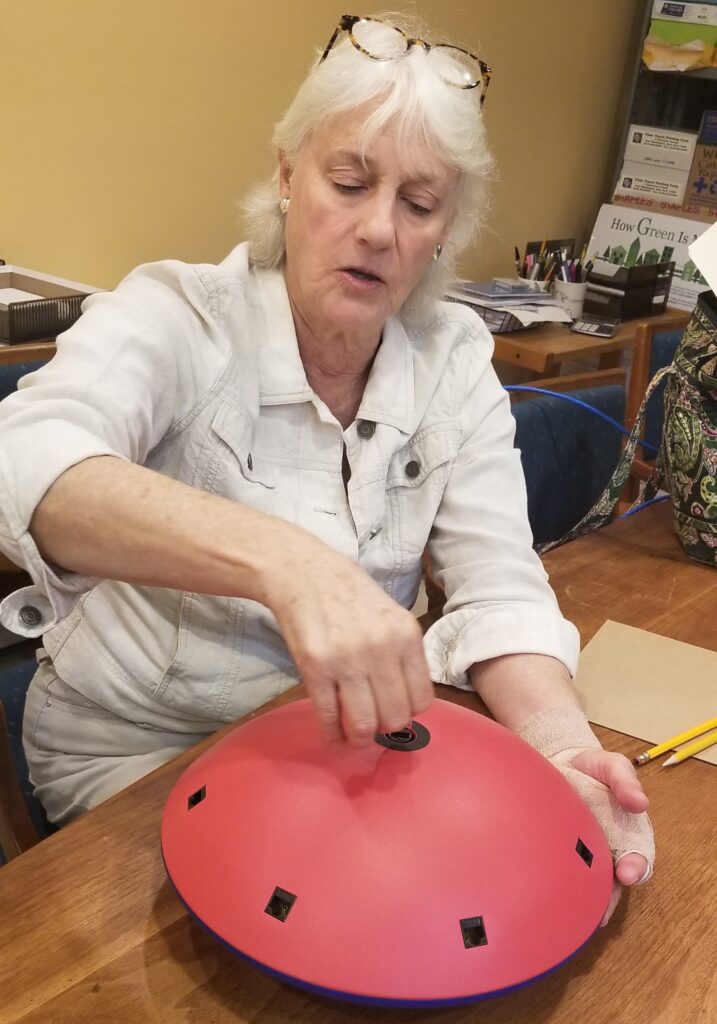
Wifi radiation-free device for schools
Adina: Could you share what are some of your future projects?
Patti: We want New York State legislation that will set up a commission to study the health and environmental impacts of wireless technologies. It would be a fair, balanced commission, including industry representatives. Also, a wireless bill about smart meters, which is also about how these devices are impacting human health. Our utilities, including oil, gas and water – are all putting smart meters on your house. And they are using this pulsed radiation, which is particularly harmful to the human body. The smart meter bill we are helping to craft would allow anyone to opt-out of a smart meter and keep their safe analog meter without being charged. Many people are developing electromagnetic sensitivity (“EMS”) or microwave sickness. It means that their body has hit a wall and they can’t tolerate exposure to anything wireless: cell phones, meters, routers, antennas, any wireless device. I mean, they can be sick to the point where they can’t go into a store, or Starbucks, or the post office or a library, or even a school classroom. They are not just feeling unwell, but are isolated.
Adina: Is there any code in medicine for that?
Patti: Yes, there are codes for microwave sickness in medicine, and it is recognized as a disability by the ADA if it prohibits you or keeps you from living in a normal way or keeps you from engaging in education or keeps you from working.
Adina: How do you diagnose though? Are there any specifics?
Patti: Yes. There are actually biomarkers for it that have been developed by a Dr. Dominique Belpomme who is in France. And then there’s Dr. Magda Havas – she’s in Canada. She has also developed these biomarkers where you can actually see clumping of red blood cells in people who have this sensitivity. Most people have no idea what’s going on. I mean, people who are really sick from this have to leave their homes because they can’t be in a neighborhood where they’re next door to a house with a smart meter. Or they can’t live in their home because there’s a big antenna two houses down, and that antenna is on 24/7. Even though they may have hardwired their own house and they don’t use wireless devices, the larger environment is making them sick. We know several people who have actually moved to a safe place in West Virginia.
Adina: Why West Virginia?
Patti: In Greenbank, West Virginia there is a NASA satellite dish that is listening to the sounds of space. And because of this satellite dish they’re not allowed to have any wireless telecommunications antennas in the area that may interfere with that communication. And so people who suffer from electromagnetic sensitivity are moving there. I’ve met a person from Westchester County with this condition who has left her husband and her two children, and has moved to West Virginia. Her husband goes down every other weekend or so, and all three of them go down to see their mother periodically. She feels okay down there, as do many other people who have moved there to live without debilitating symptoms. But when she’s up here in Westchester, she has to leave her house every night and drive into a remote area so she can sleep in her car. You have no idea how many people are doing this. It’s outrageous.
Adina: Wow, I’ve never heard of this. Could you please share your story with the town of Port Washington on the topic of the 5G antennas?
Patti: Okay. So that’s been fun – this was when Judy Bosworth was the Supervisor of the Town of North Hempstead. We did a presentation for her and a couple of council members and their legal team and we all had copies of their North Hempstead law on telecommunications infrastructure. And we had all of our changes to address the rapid proliferation of antennas in neighborhoods. Take this out, we need to put this in, they can’t put this in residential areas within 500 feet of a home, and so on. This came unfortunately after the telecoms had already made applications to place 23 antennas in the Port Washington area, and were already granted the right to do that. To prevent this from happening again, most of our changes were accepted. They really got it and did the right thing. And so that’s the new law in the Town of North Hempstead. But, you know, the telecoms are working hard at the federal level within the FCC and the local law may not be safe forever.
Because of the way Port Washington is divided up, you have the Town, and then you have all the villages making their own laws – Manorhaven, Sands Point, Baxter Estates, Flower Hill, etc. Flower Hill recently made national news because residents of Flower Hill sued big telecom over antenna installations and they won their lawsuit. It’s huge. I mean, the news went all over the United States…this tiny village of Flower Hill in Port Washington. So these are wins, right?
Adina: These things are ubiquitous in our environment and most people don’t know about them.
Patti: That’s right, and they are mostly involuntary exposures. People don’t choose to be exposed. They’re just going to be exposed because some industry has said, we’re putting our antenna here by your child’s bedroom window, or we’re putting these chemicals in your kid’s ski jacket, or we’re putting these chemicals in the takeout containers from restaurants. Coca Cola’s plastic bottles are made with antimony, a substance more toxic than arsenic. They are the largest user of plastic drink bottles in the world.
Adina: Probably that comes with big health consequences, right? I was even reading about the plastic found in fetal cells!
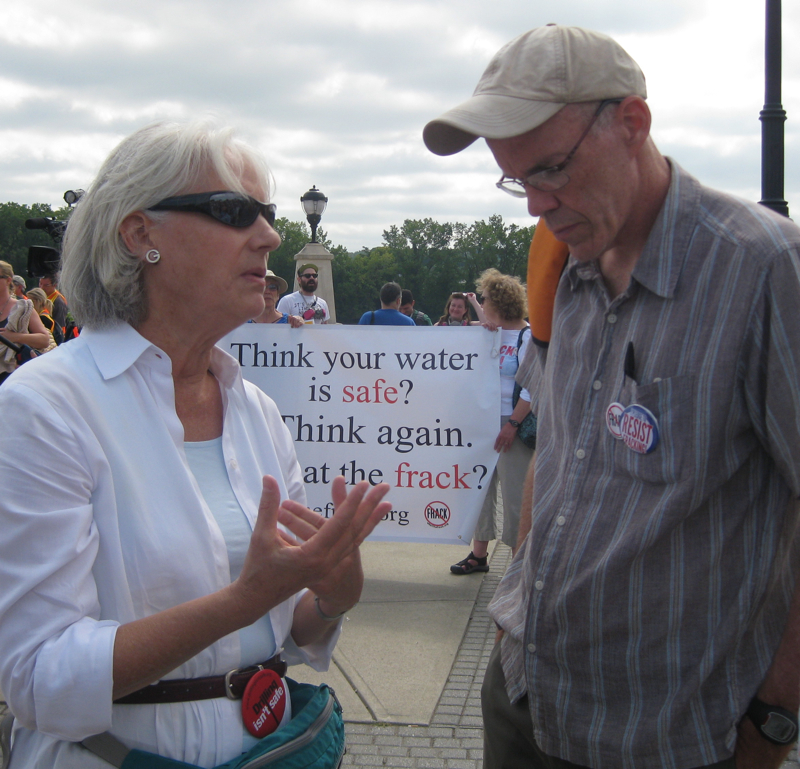
Patti: Absolutely. Many of our house furnishings, the everyday products we use and the foods we eat and their packaging contain chemicals that are absorbed by our skin, inhaled or accidentally ingested. It’s basically a chemical soup that our very youngest, our most vulnerable, are swimming in before they’re even born. There’s a fabulous writer who has done much research on this – do you know Sandra Steingraber?
Adina: No.
Patti: Oh, you have to read her book, “Living Downstream.” So let me tell you my Sandra Steingraber story, who we know pretty well because we spent a lot of time with her when we were working to get New York State to ban fracking. And we did it! I think we are still the only state in the United States that has banned fracking. So, the first time I met Sandra was in a meeting up in Massachusetts where she was the speaker. This young woman gets up to speak and she has in her hand this little jar with bluish liquid in it. She passes around the jar and when she gets it back, she says, “this is my breast milk and there are 78 industrial chemicals in it that I am feeding my newborn infant every time I breastfeed.” It was an Aha! moment and brought me into the world of chemical exposures and their impact on human health.
Adina: Yeah. Health is defined as the absence of disease, but it’s not wellbeing, it’s not wellness.
Patti: Absolutely! So, how do you narrow your focus to achieve that? The problems are so big…its about educating people and regulating polluters. And if we can get legislation or regulation to protect the most vulnerable (our children), then by default we are protecting everyone. Right?
Adina: Patti, you are a prodigy – you are so productive! I would like to know what keeps you going?
Patti: The wins we’ve had, and of course the future of our children and grandchildren. The powerful need to protect them and all innocent children is what really keeps us going! I’ve written a book for parents of children with cancer and other life-threatening illnesses and am on the fifth edition. It is about parents becoming partners in their child’s healing process by providing nutrient-dense meals and making their home safe from toxic environmental exposures. Childhood cancer rates continue to rise, even in newborns! It’s devastating.
None of the work we do is intended to make baby steps. We really can’t afford the time and effort to just move the ball a few feet. Doug is a wonderful strategist and he is always looking at how to best achieve our goal, which is to never compromise when it comes to protecting human health. We’ve recently petitioned the FDA because they are misrepresenting the science on their website. If you go to the FDA’s website and you look up “children and cell phones,” you see a picture of a girl with a cell phone plastered to her head, which even the manufacturers tell you not to do. It is not safe to hold a phone directly against your head, or even to put it in a pocket. Please look at our programs on our website [www.grassrootsinfo.org.] where you can get a sense of the scope of our work and maybe find an issue that is particularly interesting to you or your family. We spend a lot of time researching and writing and having conversations with experts on our weekly radio show who are on the cutting edge of the most critical environmental health issues. We provide print materials, videos, websites and other media on each issue so you can become an activist in your own school or community.
Adina: Patti, thank you for all your beautiful work! You are such an inspiration!
